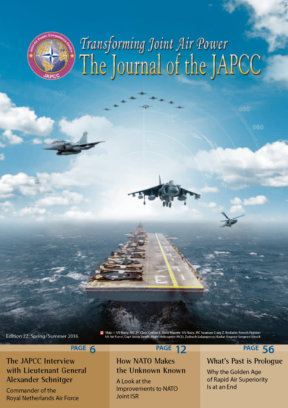Introduction / Background
In the NATO Strategic Concept, ‘Active Engagement, Modern Defence’, Cooperative Security is identified as one of the Alliance’s three core tasks. The section addressing Cooperative Security states, ‘the Alliance is affected by, and can affect, political and security developments beyond its borders. The Alliance will engage actively to enhance international security, through partnership with relevant countries and other international organizations.’1 Partnership operations are widely recognized as an important tool in NATO’s overall strategy. From NATO’s perspective, strategic partnership requires a comprehensive analysis of the societal, economic, and political conditions within a potential partner nation. NATO must refrain from committing to providing assistance or cooperation when it is either impossible or imprudent to do so. Also, it is imperative NATO and the partner nation clearly define what each wants to accomplish through a strategic partnership.
Aim / Purpose
The JAPCC study ‘Improving NATO Support to Future Air Advisor Operations’, raised questions about the best way to prepare and execute an engagement operation with a partner nation. This article is based on those questions. It looks primarily at the military aspects of establishing a partnership and presents a methodology to assess partnership development and implementation. As the political factors of strategic partnership are of prime importance, it also reflects on how these factors relate to the military phase of the operation.
A common misconception exists that strategic partnership is primarily a military endeavour. The military piece of a partnership is just one part of the relationship, but it is an important one. Strategic partnership must be based on political objectives that support both NATO and partner nation goals. Since NATO partnership efforts should include all aspects of political power (diplomatic, informational, military and economic), the NATO International Staff (IS) must provide clear guidance to the NATO International Military Staff (IMS) on the desired political objectives. The military objectives must be perfectly aligned with this political guidance and the execution adapted to the particular partnership scenario. Without clear guidance and support for these objectives from the start, any partnership effort is futile. Each partnership will be unique, based on the distinct political objectives of NATO and the partner nation. Is the main goal to improve the economic conditions within the nation, thus increasing national stability or is it simply to enhance relations between NATO and the nation? Is the goal to improve tactical integration between national and NATO forces to allow future participation in NATO-led military operations, such as what was done with the UAE and Jordan prior to OUP2, or is it to create a new strategic military capability for the partner nation, such as what was sought through partnerships in support of OEF and OIF?3 The level of training and effort associated with a partnership will be much different if the objectives are to enhance relations as compared to deterring active aggression or improving economic conditions.
Partnership Evaluation Methodology
Prior to engaging with a partner nation, NATO should perform a fundamental assessment of the nation. This should be done with the goal of increasing the efficiency of the military effort and improving the likelihood it will be effective in meeting the political objectives of both participants. Using a standardized methodology (or tool) would assist in this aim. The proposed ‘Country Baseline Assessment Methodology for Partnership’ outlined in the next paragraphs provides assessment considerations to greatly aid planners to thoroughly evaluate the general level of effort associated with a NATO partnership engagement. The proposed methodology employs the well-known Doctrine, Organisation, Training, Materiel, Leadership / Personnel, Facilities, Interoperability (DOTMLPFI) format and looks at factors for each of the DOTMLPFI areas NATO must consider prior to initiating partnership engagement.
Doctrine. NATO must consider how closely the nation’s doctrine aligns with NATO’s. If the nation’s doctrine is based on one of the NATO members, this could provide a common baseline to foster the operational and tactical partnership and greatly improve success. If doctrinal alignment or pairing is not possible, then sharing technical standards and procedures such as NATO Standardization Agreements and Allied Joint and Tactical Publications must be pursued. The NATO assistance force can provide instruction on these doctrinal references to facilitate procedural interoperability. NATO must proceed with caution in this stage. Assuring the safeguard of sensitive, protected, or classified information must remain paramount when bringing in new nations into technical and informational interoperability standards. Related to doctrine, NATO must also review a partner nation’s rules and regulations pertaining to a particular operation / activity (e.g. for air advisor operations, the partner nation’s air-related rules or restrictions may negatively impact the conduct of training and must be considered in NATO’s mission planning).
Organization. NATO must analyse the nation’s organizational structure. This analysis would determine the organizational differences as compared to a similarly-sized NATO nation and the impact they will have on the methods employed and assets required. For example, a nation may have limited rotary wing assets organized in a single unit which conducts a myriad of missions. In contrast, many NATO nations employ rotary wing units for specific missions (i.e. logistics support, air assault or attack). The organizational analysis will help to ensure the proper assets and skill sets are available and offered to the training audience.
Training. NATO must consider the quantity and the type of instruction the partner military typically receives from its nation. If they receive only limited training annually compared to NATO forces, the instructors should (or may need to) adjust the training tempo and complexity. If the nation’s education system primarily uses memorization as opposed to independent thought, it becomes an important consideration when determining training methodologies to provide instruction to the personnel. If the training audience does not speak English or French to a desired level, introductory or specific language training (such as English aviation terminology) may be required or advantageous.
Materiel. If the nation does not operate NATO-standard equipment, either training on the nation’s equipment or bringing in NATO-owned equipment to conduct training is required. An associated consideration is NATO’s desire and ability to operate and maintain the deployed training equipment. The economic conditions in the nation are also a critical factor; NATO must ensure that materiel-specific changes made as a result of the partnership are sustainable in the long-term, i.e. after NATO assistance forces depart. If not, it is highly likely the nation will revert back to its previous state and NATO’s intervention / assistance mission becomes a true failure. (This may also be true of other DOTMLPFI changes made as a result of the partnership.)
Leadership and Personnel. These are both considerations when establishing partnerships. NATO must consider whether the nation is a ‘Western-based’ military culture. If not, leaders must determine how this will affect the ability of the combined force to meet mission objectives. In particular, religious considerations must be assessed for potential impact to training delivery. Other relevant considerations to assess include:
- The nation’s military composition. (Are they a voluntary versus conscripted forces or some mix?)
- Is the military culture influenced by religion or the political system?
- The roles of the Non-commissioned and Junior Officers. (e.g. Is command decision-making retained at the senior officer level? How strict is rank differentiation maintained? Could the NCO corps be considered professional?)
- Does NATO have an existing exchange program with a NATO nation which can be used as a conduit for initiating a more extensive partnership program?
- NATO trainers must be aware of the level of popular support for NATO forces in the nation. This may provide a rough gauge for force protection requirements and the partner nation’s force’s enthusiasm to work with the assistance force.
Facilities. The facilities the partner nation intends to provide the NATO force must be considered, particularly for the level of force protection potential. Regarding force protection for the assistance force, a balance must be struck to ensure an adequate level of security is provided without appearing to be an occupying force to the local populace. Access to medical facilities, messing facilities, embassies and evacuation locations must also be considered. Related to facilities, the nation’s quality, range, and level of infrastructure must be examined. This must be done to determine transportation and other logistical requirements for the NATO assistance forces. For example, tactical airlift may be needed to conduct the operation if surface vehicles are inadequate.
Interoperability. Finally, doctrinal and technical interoperability with the nation is important in NATO military partnership efforts. Both must be addressed prior to initiation of training events. Doctrinal interoperability has already been discussed. Technical interoperability may require NATO forces to bring additional hardware (such as radios or other communication equipment) to ensure operations are not impeded due to interoperability issues.
Summary
When considering partnerships, it must be stressed that the military partnership operations are being executed for only one reason – meeting NATO’s and the partner nation’s stated political objectives. These objectives can range from improving regional stability, creating an environment for economic growth or even to deter or defeat aggression. Using the proposed Country Baseline Assessment Methodology for Partnership to analyse the military element of the operations would help to ensure scarce assets are used efficiently and effectively. If partnerships are properly developed and executed, they can enhance conditions for lasting stability which in turn can reduce or eliminate NATO contingency response requirements. This will result in a significant return on the investment made towards developing a robust NATO partnership capability.












